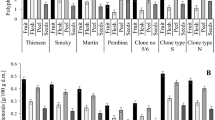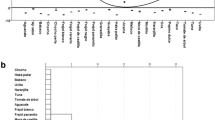Abstract
The aim of this work was to characterize antioxidant properties, establish the profile of polyphenolic compounds and evaluate the content of tocopherols in walnut fruits. The research material consisted of eleven walnut varieties which were examined for dry matter content, fats and minerals content. Their antioxidant capacity was determined by the ABTS, DPPD and FRAP assays. The profile of polyphenolic compounds was established by means of ultra-high performance liquid chromatography coupled with a mass detector (UPLC–PDA–ESI–MS). In addition, tocopherols (α, β, γ and δ) were quantified using high-pressure liquid chromatography (HPLC). Walnut fruits differed significantly in terms of their physicochemical parameters, antioxidant properties and the content of bioactive compounds. Walnuts of the Lake cultivar exhibited the strongest antioxidant potential, while those of the U02 had the highest content of total polyphenols (2.07 g/100 g). Phenolic acids, among which gallic acid, protocatechuic acid, syringic acid, and genistinic acid were identified, dominated in the polyphenol profile. In turn, the spectrum of tocopherols contained four isoforms: α, β, γ and δ. In the examined walnuts, the total tocopherol content ranged from 19.83 mg/kg (U17) to 126.00 mg/kg (Lake) and β- and δ-tocopherols were present in major quantities.

Similar content being viewed by others
References
Abdallah IB, Tlili N, Martinez-Force E, Preze Rubio AG, Perez-Camino MC, Albouchu A, Boukhchina S (2015) Content of carotenoids, tocopherols, sterols, triterpenic and aliphatic alcohols, and volatile compounds in six walnuts (Juglans regia L.) varieties. Food Chem 173:972–978
FAO (2008) Food and Agriculture Organisation, Rome
Labuckas DO, Maestri D, Perello M, Martinez LM, Lamarqu AL (2008) Phenolics from walnut (Juglans regia L.) kernels: antioxidant activity and interactions with proteins. Food Chem 107:607–612
Stampar F, Solar A, Hudina M, Veberic R, Colaric M (2006) Traditional walnut liqueur—cocktail of phenolics. Food Chem 95:627–631
Martinez ML, Mattea MA, Maestri DM (2008) Pressing and super-critical carbon dioxide extraction of walnut oil. J Food Eng 88:399–404
Pereira JA, Oliveira I, Sousa A, Ferreira ICFR, Bento A, Letícia EM (2008) Bioactive properties and chemical composition of six walnut (Juglans regia L.) cultivars. Food Chem Toxicol 46:2103–2111
Pereira JA, Oliveira I, Sousa A, Valentăo P, Andrade PB, Ferreira ICFR, Ferreres F, Bento A, Seabra R, Estevinho L (2007) Walnut (Juglans regia L.) leaves: phenolic compounds, antimicrobial activity and antioxidant potential of different cultivars. Food Chem Toxicol 45:2287–2295
Oliveira I, Sousa A, Ferreira ICFR, Bento A, Estevinho L, Pereira JA (2008) Total phenols, antioxidant potential and antimicrobial activity of walnut (Juglans regia L.) green husky. Food Chem Toxicol 46:2326–2331
Amaral JS, Alves M, Seabra R, Oliveira B (2005) Vitamin E composition of walnuts (Juglans regia L.): a 3-year comparative study of different cultivars. J Agric Food Chem 53:5467–5472
AOAC. Official Methods of Analysis of AOAC International, 17th ed.; Horwitz, W., Ed.; AOAC: Arlington, VA, 2000; Vol. II, 40, 1–3
Re R, Pellegrini N, Proteggente A, Pannala A, Yang M, Rice-Evans C (1999) Antioxidant activity applying an improved ABTS radical cation decolorization assay. Free Radical Biol Med 26:1231–1237
Yen GC, Chen HY (1995) Antioxidant activity of various tea extracts in relation to their antimutagenicity. J Agric Food Chem 43:27–32
Benzie IFF, Strain JJ (1996) The ferric reducing ability of plasma (FRAP) as a measure of antioxidant power: the FRAP assay. Anal Biochem 239:70–76
Xianggun G, Ohlander M, Jeppson N, Bjork L (2000) Changes in antioxidant effects and their relationship to phytonutrients in fruits of sea buckthorn during maturation. J Agric Food Chem 48:1485–1490
Kornsteiner M, Karl-Heinz W, Ibrahim E (2006) Tocopherols and phenolics in 10 different nut types. Food Chem 98:381–387
Savage GP (2001) Chemical composition of walnuts (Juglans regia L.) grown in New Zealand. Plant Food Hum Nutr 56:75–82
Li L, Tsao R, Yang R, Karmer JK, Hernandez M (2007) Fatty acid profiles, tocopherol contents, and antioxidant activities of heartnut (Juglans ailanthifolia Var. cordiformis) and Persian Walnut (Juglans regia L.). J Agric Food Chem 55:1164:1169
Bolling BW, Chen C-YO, McKay DL, Blumberg JB (2011) Tree nut phytochemicals: composition, antioxidant capacity, bioactivity, impact factors. A systematic review of almonds, Brazils, cashews, hazelnuts, macadamias, pecans, pine nuts, pistachios and walnuts. Nutr Res Rev 24(02):244–275
Persic M, Mikulic-Petkovsek M, Slatnar A, Solar A, Veberic R (2018) Changes in phenolic profiles of red-colored pellicle walnut and hazelnut kernel during ripening. Food Chem 252:349–355
Cerit I, Saricam A, Demirkol O, Unver H, Sakar E, Cosansu S (2017) Comparative study of functional properties of eight walnut (Juglans regia L.) genotypes. Food Sci Tech 37(3):272–277
Nawwar MAM, Hussein SAM, Merfort I (1994) NMR spectral analysis of polyphenols from Punica granatum. Phytochem 36:793–798
Mahoney N, Molyneux RJ, Campbell BC (2000) Regulation of aflatoxin production by naphthoquinones of walnut (Juglans regia L.). J Agric Food Chem 48:4418–4421
Miraliakbari H, Shahidi F (2008) Antioxidant activity of minor components of tree nuts oil. Food Chem 111:421–427
Author information
Authors and Affiliations
Corresponding author
Ethics declarations
Conflict of interest
The authors have declared no conflict of interests.
Compliance with ethics requirements
This article does not contain any studies with human and animal subjects.
Rights and permissions
About this article
Cite this article
Pycia, K., Kapusta, I., Jaworska, G. et al. Antioxidant properties, profile of polyphenolic compounds and tocopherol content in various walnut (Juglans regia L.) varieties. Eur Food Res Technol 245, 607–616 (2019). https://doi.org/10.1007/s00217-018-3184-3
Received:
Accepted:
Published:
Issue Date:
DOI: https://doi.org/10.1007/s00217-018-3184-3




